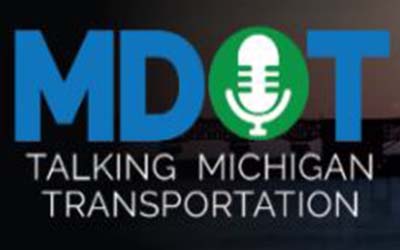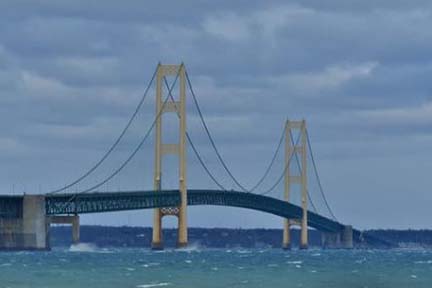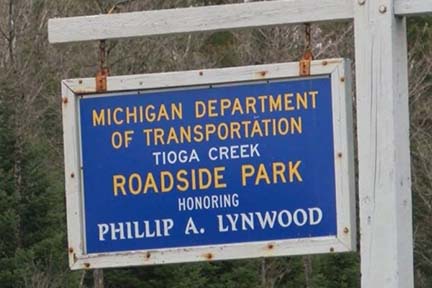
Predicting how long a road will last
|
|
|
|
|

|
|
|
|
|


| FOR IMMEDIATE RELEASE May 15, 2025
|
MEDIA CONTACT James Lake 906-250-0993 [email protected] |
Weather delays Mackinac Bridge joint replacement completion
ST. IGNACE, Mich. – Cold, rainy weather early in the season has delayed completion of this year’s work to repave portions of the Mackinac Bridge and replace a modular joint, which will result in extended lane closures.
While contractors have completed replacement of half of the modular joint over Pier 34 on the bridge at the start of the north viaduct span, as well as repair and repaving the southbound lanes of the north viaduct, work continues on replacing the other half of the modular joint on the northbound lanes of the bridge. That work is currently anticipated to be completed by May 29, about a week later than expected.
“We worked with the contractor to ensure that the planned work could be completed prior to the Memorial Day weekend, but poor weather conditions delayed this year’s start of work and the modular joint installation took longer than expected,” said Bridge Director Kim Nowack. “Unfortunately, this means that there will be lane closures in place for the holiday weekend, but crews are working diligently to wrap the project up and get those lanes reopened.”
Weekend traffic peaks between 10 a.m. and 4 p.m. often result in traffic backups, even with all toll lanes open. Drivers should consider crossing at off-peak times or prepare for delays.
“While Memorial Day weekend typically marks the seasonal increase in traffic volumes on the bridge, we fortunately did not see backups during last year’s work, and traffic flowed smoothly,” Nowack said. “We hope that will be the case this holiday weekend.”
To ensure the work is completed prior to the seasonal rise in traffic volumes on the bridge, the scope of work for this season was reduced with the goal of reopening all lanes of the bridge before Memorial Day weekend.
Deck repairs and repaving of the remaining sections of the southbound side of the bridge will be scheduled at a later date as a separate project.
Last year, the northbound side of the bridge was repaired and repaved. While scheduled for completion prior to Memorial Day 2024, work and lane closures extended into mid-June.

|
|
|
|
|

 |
| FOR IMMEDIATE RELEASE May 7, 2025 |
MEDIA CONTACT Dan Weingarten 906-250-4809 [email protected] |
MDOT lifting all remaining spring weight restrictions Friday
LANSING, Mich. - Effective 6 a.m. Friday, May 9, the Michigan Department of Transportation (MDOT) will lift the remaining seasonal weight restrictions on all state trunkline highways in the state of Michigan. State routes typically carry M, I or US designations.
Weight restrictions are implemented during the spring frost thaw period and are now completed for the 2025 season.
County road commissions and city public works departments put in place their own seasonal weight restrictions, which usually, but not always, coincide with state highway weight restrictions. Signs are generally posted to indicate which routes have weight restrictions in effect.
For weight restriction information and updates, call 800-787-8960, or you can access this information on MDOT’s website at www.Michigan.gov/Truckers, under “Restrictions.” All-season routes are designated in green and gold on the MDOT Truck Operators Map, which is available online. You also may sign up to receive e-mail alerts.
Trucking companies located in New Jersey and Canada can obtain information by calling 517-373-6256.

|
|
|
|
|

 |
| FOR IMMEDIATE RELEASE April 22, 2025 |
MEDIA CONTACT Dan Weingarten 906-250-4809 [email protected] |
Most MDOT roadside parks reopening April 28
LANSING, Mich. – Roadside parks operated by the Michigan Department of Transportation (MDOT) will reopen for the season Monday, April 28.
MDOT maintains 85 roadside parks around the state. Some parks operate seasonally, usually closing in late October and reopening in the spring.
The following roadside parks will remain closed until later this year due to weather, maintenance or construction activities:
Alger County
Baraga County
Calhoun County
Huron County
Ingham County
Keweenaw County
Sanilac County
While most parks are scheduled to reopen April 28, motorists should not expect drinking water at all parks to be turned on until sometime later in May, after annual testing and treatment of the park water systems is completed.
A map showing the status of MDOT roadside parks is available on the MDOT website.